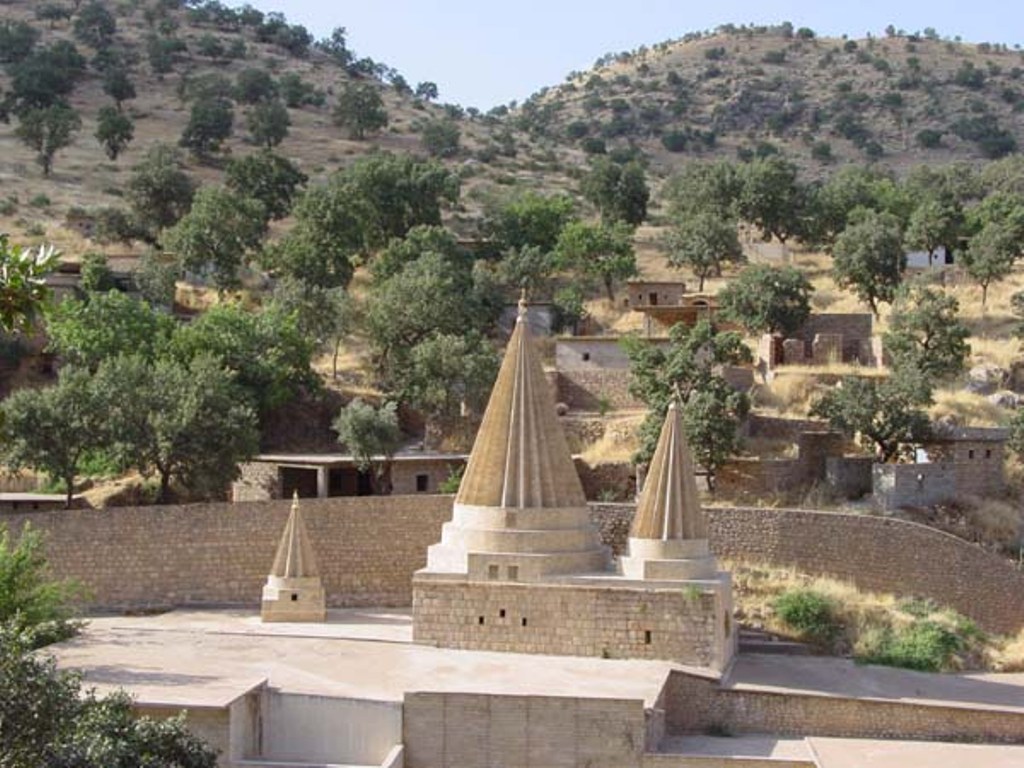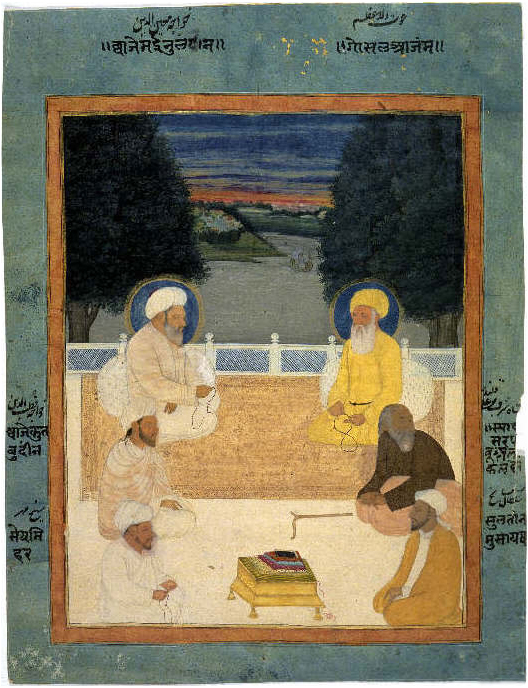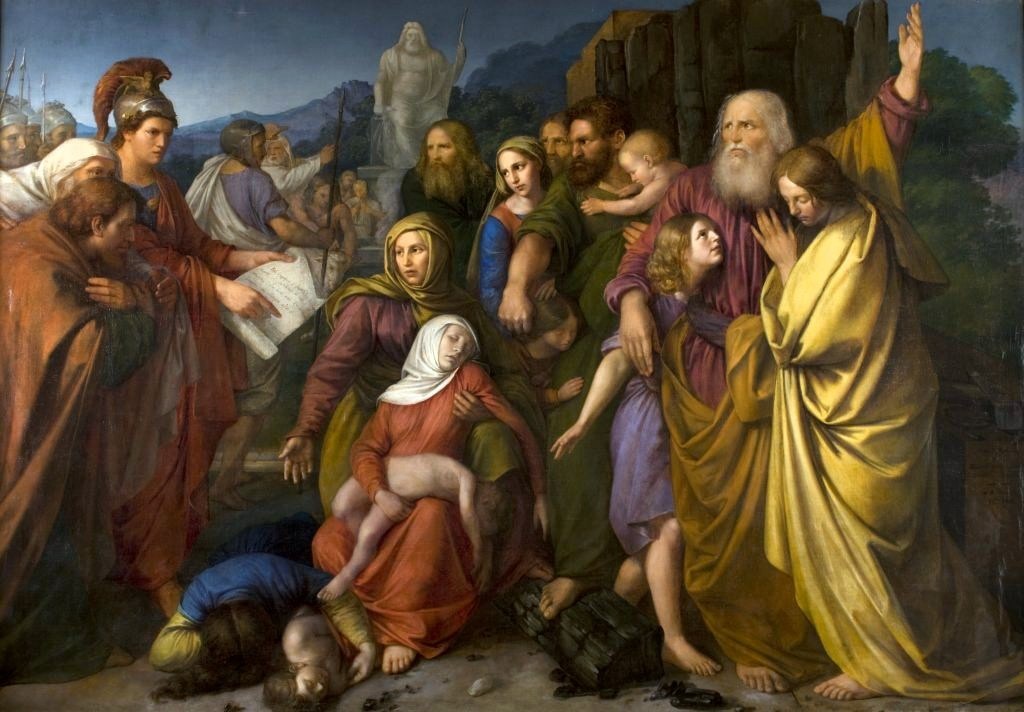|
Sultan Ezid Temple
Sultan Ezid Temple is a Yazidi temple located in Tbilisi, the capital of Georgia. Architecture The temple is modeled on the Lalish temple, the holiest Yazidi temple located in Iraq and has a single spire and bare-walled exteriors similar to the Lalish temple. The premises also contain a pyramid-shaped glass building where courses on the Yazidi religion and history, as well as Georgian and Kurdish languages, are taught. History The temple was opened in June 2015 and is named after Sultan Ezid, one of the holy men of the Yazidi faith. The temple is constructed on land donated by the Georgian Government in 2009, and the construction project was initiated in 2012 by the House of Yezidis of Georgia and financed by local businessmen. At the time of its opening in 2015, it was only the second Yazidi temple outside of Iraq. Yazidis are one of the ethnic minorities in Georgia, practicing an ancient, monotheistic belief that has similarities to Christianity, Hinduism, Judaism, Su ... [...More Info...] [...Related Items...] OR: [Wikipedia] [Google] [Baidu] |
Yazidism
Yazidism , alternatively Sharfadin is a monotheistic ethnic religion that has roots in a western Iranic pre-Zoroastrian religion directly derived from the Indo-Iranian tradition. It is followed by the mainly Kurmanji-speaking Yazidis and is based on belief in one God who created the world and entrusted it into the care of seven Holy Beings, known as Angels. Preeminent among these Angels is Tawûsê Melek (also spelled as "Melek Taûs"), who is the leader of the Angels and who has authority over the world. History Principal beliefs Yazidis believe in one God, whom they refer to as ', , ', and ' ('King'), and, less commonly, ' and '. According to some Yazidi hymns (known as ''Qewls''), God has 1,001 names, or 3,003 names according to other Qewls. In Yazidism, fire, water, air, and the earth are sacred elements that are not to be polluted. During prayer Yazidis face towards the sun, for which they were often called "sun worshippers". The Yazidi myth of creation begins with ... [...More Info...] [...Related Items...] OR: [Wikipedia] [Google] [Baidu] |
Christianity
Christianity is an Abrahamic monotheistic religion based on the life and teachings of Jesus of Nazareth Jesus, likely from he, יֵשׁוּעַ, translit=Yēšūaʿ, label=Hebrew/Aramaic ( AD 30 or 33), also referred to as Jesus Christ or Jesus of Nazareth (among other names and titles), was a first-century Jewish preacher and religious .... It is the Major religious groups, world's largest and most widespread religion with roughly 2.38 billion followers representing one-third of the global population. Its adherents, known as Christians, are estimated to make up a majority of the population in Christianity by country, 157 countries and territories, and believe that Jesus in Christianity, Jesus is the Son of God (Christianity), Son of God, whose coming as the Messiah#Christianity, messiah was Old Testament messianic prophecies quoted in the New Testament, prophesied in the Hebrew Bible (called the Old Testament in Christianity) and chronicled in the New Testamen ... [...More Info...] [...Related Items...] OR: [Wikipedia] [Google] [Baidu] |
List Of Yazidi Holy Places ...
This is a list of Yazidi temples across the world. Background Yazidis are an ethnoreligious group who live predominantly in northern Iraq. Their religion is known as Yazidism. List See also * List of Yazidi saints * List of Yazidi settlements * Yazidism * Yazidis References External links {{Commons category-inline * Yazidi Yazidi Yazidis or Yezidis (; ku, ئێزیدی, translit=Êzidî) are a Kurmanji-speaking endogamous minority group who are indigenous to Kurdistan, a geographical region in Western Asia that includes parts of Iraq, Syria, Turkey and Iran. The ma ... [...More Info...] [...Related Items...] OR: [Wikipedia] [Google] [Baidu] |
Quba Mere Diwane
Quba () is a city and the administrative centre of the Quba District (Azerbaijan), Quba District of Azerbaijan. The city lies on the north-eastern slopes of Mount Shahdagh, Shahdag mountain, at an altitude of 600 metres above sea level, on the right bank of the Kudyal river. It has a population of 38,100 (2010). History Quba was mentioned in works of various European geographers, in ancient Arabic and Albania (Caucasus), Albanian sources. The castle built by the ruler Anushiravan in the 11th century was called "Bade-Firuz Qubat", and in the Arabic sources of the XII century Quba was mentioned as "Cuba". In the 13th century, in the Dictionary of Geographical names of Arabs, Arabian scientist Hamabi it was mentioned among the List of cities in Azerbaijan, Azerbaijani cities as Kubba, and in the sources of 16th century Quba was referred to as "Dome". Guba (Quba) city originated from the riverside village of Gudial. In the mid-18th century, after moving his residence from Khudat, ... [...More Info...] [...Related Items...] OR: [Wikipedia] [Google] [Baidu] |
Yazidis In Georgia
The Yazidis in Georgia are a part of the Yazidis who fled from the Ottoman Empire due to persecution in the 19th and early 20th centuries and sought refuge in Georgia. History The Yazidis in Georgia are among the poorest and most persecuted people in Georgia. In the Soviet Union there was almost no contact between Yazidis in Georgia and Yazidis in Armenia with the Yazidis in Iraq, Turkey and Syria. In 1989 there were 33,000 Yazidis in Georgia. After the collapse of the Soviet Union in the 1990s, thousands of Yazidis fled from Georgia to Germany because of persecution and discrimination. In 2008, the number of Yazidis in Georgia was 12,000. In 1919 the Yazidis received permission from the Georgian government to register an organization called ''The Yezidi Ethno-Nationality Consultative Council'' in Tbilisi Tbilisi ( ; ka, თბილისი ), in some languages still known by its pre-1936 name Tiflis ( ), is the capital and the largest city of Georgia, lying on the ba ... [...More Info...] [...Related Items...] OR: [Wikipedia] [Google] [Baidu] |
Solar Deity
A solar deity or sun deity is a deity who represents the Sun, or an aspect of it. Such deities are usually associated with power and strength. Solar deities and Sun worship can be found throughout most of recorded history in various forms. The Sun is sometimes referred to by its Latin name ''Sol'' or by its Greek name ''Helios''. The English word ''sun'' derives from Proto-Germanic *''sunnǭ''. Overview Predynasty Egyptian beliefs attribute Atum as the Sun god and Horus as god of the sky and Sun. As the Old Kingdom theocracy gained influence, early beliefs were incorporated into the expanding popularity of Ra and the Osiris-Horus mythology. Atum became Ra-Atum, the rays of the setting Sun. Osiris became the divine heir to Atum's power on Earth and passed his divine authority to his son, Horus. Other early Egyptian myths imply that the Sun is incorporated with the lioness Sekhmet at night and is reflected in her eyes; or that the Sun is found within the cow Hathor du ... [...More Info...] [...Related Items...] OR: [Wikipedia] [Google] [Baidu] |
Zoroastrianism
Zoroastrianism is an Iranian religion and one of the world's oldest organized faiths, based on the teachings of the Iranian-speaking prophet Zoroaster. It has a dualistic cosmology of good and evil within the framework of a monotheistic ontology and an eschatology which predicts the ultimate conquest of evil by good. Zoroastrianism exalts an uncreated and benevolent deity of wisdom known as ''Ahura Mazda'' () as its supreme being. Historically, the unique features of Zoroastrianism, such as its monotheism, messianism, belief in free will and judgement after death, conception of heaven, hell, angels, and demons, among other concepts, may have influenced other religious and philosophical systems, including the Abrahamic religions and Gnosticism, Northern Buddhism, and Greek philosophy. With possible roots dating back to the 2nd millennium BCE, Zoroastrianism enters recorded history around the middle of the 6th century BCE. It served as the state religion of the ancient Iran ... [...More Info...] [...Related Items...] OR: [Wikipedia] [Google] [Baidu] |
Sufism
Sufism ( ar, ''aṣ-ṣūfiyya''), also known as Tasawwuf ( ''at-taṣawwuf''), is a mystic body of religious practice, found mainly within Sunni Islam but also within Shia Islam, which is characterized by a focus on Islamic spirituality, ritualism, asceticism and esotericism. It has been variously defined as "Islamic mysticism",Martin Lings, ''What is Sufism?'' (Lahore: Suhail Academy, 2005; first imp. 1983, second imp. 1999), p.15 "the mystical expression of Islamic faith", "the inward dimension of Islam", "the phenomenon of mysticism within Islam", the "main manifestation and the most important and central crystallization" of mystical practice in Islam, and "the interiorization and intensification of Islamic faith and practice". Practitioners of Sufism are referred to as "Sufis" (from , ), and historically typically belonged to "orders" known as (pl. ) – congregations formed around a grand who would be the last in a chain of successive teachers linking back to Muh ... [...More Info...] [...Related Items...] OR: [Wikipedia] [Google] [Baidu] |
Judaism
Judaism ( he, ''Yahăḏūṯ'') is an Abrahamic, monotheistic, and ethnic religion comprising the collective religious, cultural, and legal tradition and civilization of the Jewish people. It has its roots as an organized religion in the Middle East during the Bronze Age. Modern Judaism evolved from Yahwism, the religion of ancient Israel and Judah, by the late 6th century BCE, and is thus considered to be one of the oldest monotheistic religions. Judaism is considered by religious Jews to be the expression of the covenant that God established with the Israelites, their ancestors. It encompasses a wide body of texts, practices, theological positions, and forms of organization. The Torah, as it is commonly understood by Jews, is part of the larger text known as the ''Tanakh''. The ''Tanakh'' is also known to secular scholars of religion as the Hebrew Bible, and to Christians as the "Old Testament". The Torah's supplemental oral tradition is represented by later tex ... [...More Info...] [...Related Items...] OR: [Wikipedia] [Google] [Baidu] |
Hinduism
Hinduism () is an Indian religion or ''dharma'', a religious and universal order or way of life by which followers abide. As a religion, it is the world's third-largest, with over 1.2–1.35 billion followers, or 15–16% of the global population, known as Hindus. The word ''Hindu'' is an exonym, and while Hinduism has been called the oldest religion in the world, many practitioners refer to their religion as '' Sanātana Dharma'' ( sa, सनातन धर्म, lit='the Eternal Dharma'), a modern usage, which refers to the idea that its origins lie beyond human history, as revealed in the Hindu texts. Another endonym is ''Vaidika dharma'', the dharma related to the Vedas. Hinduism is a diverse system of thought marked by a range of philosophies and shared concepts, rituals, cosmological systems, pilgrimage sites, and shared textual sources that discuss theology, metaphysics, mythology, Vedic yajna, yoga, agamic rituals, and temple building, among other topi ... [...More Info...] [...Related Items...] OR: [Wikipedia] [Google] [Baidu] |
Ethnic Minorities In Georgia (country)
The main ethnic minorities in Georgia are Azerbaijanis, Armenians, Ukrainians, Russians, Greeks, Abkhazians, Ossetians, Kists, Assyrians and Yazidi. Ethnic minorities According to the "National Integration and Tolerance in Georgia Assessment Survey Report" 2007–2008, implemented by the UN Association of Georgia and supported by USAID, the following ethnic groups are living in Georgia: Historical background Georgia's ethnic composition varied from one historical epoch to another and this happened as the result of certain economic, political or social factors. Georgian academic Vakhtang Jaoshvili identified four major stages in the history of Georgia that influenced the ethnic composition of Georgia: from medieval times to the late 18th century; from the 19th century to the 1921 Soviet invasion of Georgia; from 1921 to the collapse of the USSR; and present days, starting with the Georgian declaration of independence. As Georgia during medieval times remained the victim of m ... [...More Info...] [...Related Items...] OR: [Wikipedia] [Google] [Baidu] |
Tbilisi
Tbilisi ( ; ka, თბილისი ), in some languages still known by its pre-1936 name Tiflis ( ), is the capital and the largest city of Georgia, lying on the banks of the Kura River with a population of approximately 1.5 million people. Tbilisi was founded in the 5th century AD by Vakhtang I of Iberia, and since then has served as the capital of various Georgian kingdoms and republics. Between 1801 and 1917, then part of the Russian Empire, Tiflis was the seat of the Caucasus Viceroyalty, governing both the northern and the southern parts of the Caucasus. Because of its location on the crossroads between Europe and Asia, and its proximity to the lucrative Silk Road, throughout history Tbilisi was a point of contention among various global powers. The city's location to this day ensures its position as an important transit route for energy and trade projects. Tbilisi's history is reflected in its architecture, which is a mix of medieval, neoclassical, Beaux Art ... [...More Info...] [...Related Items...] OR: [Wikipedia] [Google] [Baidu] |





_p012_BAKU%2C_FIRE_TEMPLE_(cropped).jpg)



